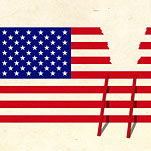BILLINGS, Mont. (AP) — As many as 360 migrating wild bison would be shot by hunters in Montana, captured for slaughter or shipped elsewhere this winter under a proposal from Yellowstone National Park officials seeking an alternative to the indiscriminate slaughters of previous years.
Officials Seek New Ways to Cull Bison
By THE ASSOCIATED PRESS
Published: November 20, 2011
Janie Osborne/Associated Press
Bison outside Yellowstone National Park. Park officials are seeking an alternative to the slaughters of previous years.
Documents obtained by The Associated Press show that officials are considering “selective culls” to help reduce the park’s bison population to 3,000 from 3,700. Some of this winter’s anticipated decrease would come from natural deaths.
The proposal comes amid rising pressure from Montana officials, including Gov. Brian Schweitzer, to rein in the size of Yellowstone’s iconic bison herds. Others say the animals should roam freely, although cattle ranchers worry that that could bring unwanted competition for grazing space and spread the animal disease brucellosis.
Park biologists wrote in the proposal that reducing the population could avert the need for large-scale slaughters like those of past migrations, when bison left the park in large numbers in harsh winters to seek food at lower elevations. In 2008, more than 1,700 were killed or removed.
State officials said hunting was their top choice for population control. Mr. Schweitzer said in an interview that for that strategy to work, however, the park must open its borders to hunting because hunts during mild winters, when the animals did not cross out of the park, yielded few bison.
“These things have to have some give and take,” Mr. Schweitzer said. “The buffalo doesn’t know there the line is when it leaves the park. We end up taking care of the oversupply of bison because they aren’t managing their population within the park.”
Yellowstone administrators declined a request to interview the biologists who wrote the proposal. A park spokesman, Al Nash, said that it was a draft document subject to change, but that hunting inside the park would not be considered.
Still, after years of public acrimony over the slaughters, Mr. Nash said, the park is looking for a new and lasting approach to bison management.
“Everybody would agree that we would rather not see large culls of animals,” Mr. Nash said.
More than 3,600 Yellowstone bison were removed over the last decade to prevent the spread of brucellosis. That included the number in 2008, when Yellowstone’s temporary bison capture pens were overwhelmed.
Brucellosis can cause pregnant animals to miscarry and has been eradicated nationwide except in the Yellowstone region.
Tens of millions of bison once roamed North America. Only about 20,000 wild bison remain, and Yellowstone’s are considered among the most genetically pure.
A representative of the Fort Peck Indian Reservation in northeast Montana said slaughtering those prized bison did not make sense when tribes had been trying for several years to get Yellowstone bison to start new herds outside the park.
“If they want to give them to the tribes, they wouldn’t have this problem,” said Robert Magnum, a fish and game warden at Fort Peck.
Park officials predict that this winter’s migration will top 1,000 bison from the park’s two herds, potentially offering an early test of the culling proposal if other state and federal agencies approve it.
In years without major migrations, Yellowstone’s bison population grew relatively unchecked. That set the stage for yet more slaughters when the population peaked again.
“These large removals that have happened every few years are a black mark on everybody,” said Dr. Marty Zaluski, the Montana state veterinarian. “We need to manage with regular, smaller removals to regulate those peaks and valleys.”
The proposal calls for 200 female bison, 50 calves and 50 yearlings from the park’s northern herd to be shot by hunters, captured for relocation or captured for slaughter. The slaughter would focus on animals that test positive for disease exposure.
Thirty bull bison from the park’s central herd would be killed by hunters. An additional 20 to 30 bulls from the northern herd could be removed during a late-winter hunt of animals that resist returning to the park.
Relocated bison could be shipped elsewhere to establish new herds or to be used for research, the proposal states.














